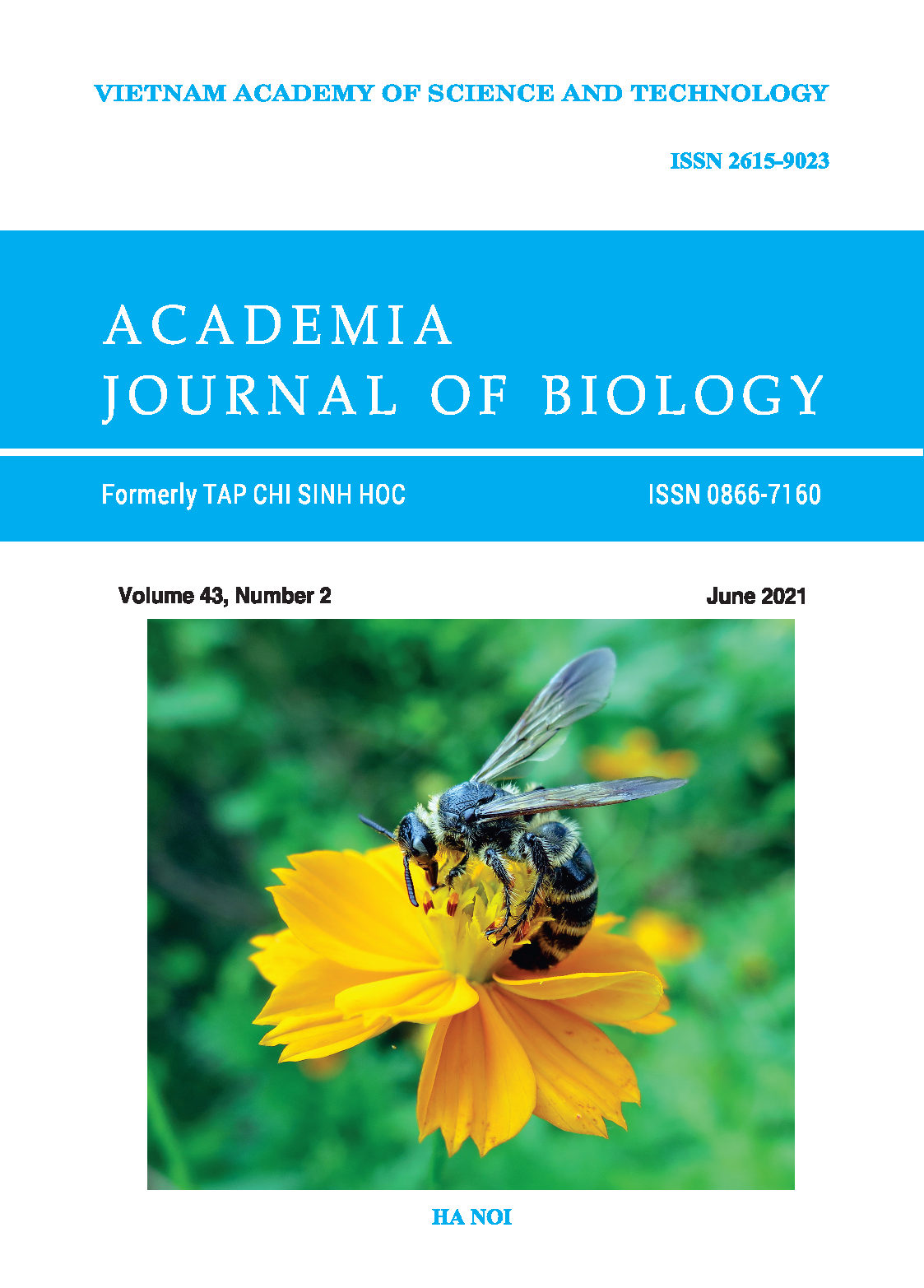Isolation and identification of endophytic fungi from Catharanthus roseus and Scutallaria barbata
Author affiliations
DOI:
https://doi.org/10.15625/2615-9023/15920Keywords:
Albifimbria sp., Catharanthus roseus, Cladosporium sp., Corynespora sp., endophytic fungi, ITS sequencing, Scutallaria barbata, surface sterilizationAbstract
Endophytic fungi, microfungi that internally infect living plant tissues, are reported to have the ability to synthesize many enzymes, plant growth hormones and pharmaceutically active compounds similar to those in their hosted plants. This has opened a potential path of using endophytic fungi as a bioreactor for mass production of bioactive compounds at a lower cost. Therefore, it is necessary to establish a robust procedure for the isolation and identification of potential fungal strains that are capable of producing desired biological compounds. In this study, we reported an effective procedure for surface sterilization of 3 types of tissue samples (root, shoot and leaf) of 2 herbaceous plants (Catharanthus roseus and Scutallaria barbata) using commercial bleach (5% NaOCl), isolation of endophytic fungi from the sterilized samples and identification of isolated fungal strains by ITS sequencing analysis. A total of 48 endophytic fungi were successfully isolated from plant samples collected from Dan Phuong (Ha Noi), Phu Dien (Ha Noi) and Hai Duong city (Hai Duong). Based on results of morphological observation and ITS sequencing analysis, 48 endophytic fungi were classified to one of the four species, including Clasdosporium colombiae, Cladosporium halotolerans, Corynespora cassiicola and Albifimbria terrestris. The potential of the isolated endophytic fungal species for the mass production of pharmacologically active compounds will be investigated in future studies.
Downloads
References
Ahmad M., Nangyal H., Imran M., 2016. Optimization of protocol for surface sterilization and callus induction for three rice varieties. J. Agric. Environ. Sci., 16 (2): 357-361.
Arnold A. E., Maynard Z., Gilbert G. S., Coley P. D., Kursar T. A., 2000. Are tropical fungal endophytes hyperdiverse? Ecol. Lett. 3(4): 267-274.
Jan A., Bhat K. M., Mir M. A., Bhat M. A., Wani I. A., Rather J. A., 2013. Surface sterilization method for reducing microbial contamination of field grown strawberry explants intended for in vitro culture. Afr. J. Biotechnol. 12(39): 5749-5753.
Jia M., Chen L., Xin H. L., 2016. A friendly relationship between endophytic fungi and medicinal plants: A systematic review. Front. Microbiol. 7: 906-921.
Manici L. M., Kelderer M., Caputo F., Mazzola M., 2015. Auxin-mediated relationships between apple plants and root inhabiting fungi: Impact on root pathogens and potentialities of growth-promoting populations. Plant Pathol. 64: 843-851.
Nguyen Đuc Anh, Nguyen Giang Sơn, 2016. Molecular data and premilinary phylogeny of several Paradoxosomatid millipede species in Vietnam (Diplopoda: Polydesmida: Paradoxosomatideae). Vietnam J. Biotechnol. 38(2): 146-153 (In Vietnamese with English summary)
Nongalleima K., Dikash Singh T., Amitabha D., Deb L., Sunitibala Devi H., 2013. Optimization of surface sterilization protocol, induction of axillary shoots regeneration in Zingiber zerumbet (L.) Sm. as affected by season. Biol. Rhythm Res.: 45(2): 317-324.
Palem P. P. C., Kuriakose G. C., Jayabaskaran C., 2015. An endophytic fungus, Talaromyces radicus, isolated from Catharanthus roseus, produces Vincristine and Vinblastine, which induce apoptotic cell death. PLoS ONE 10(12): 1-22.
Peng J., Lin T., Wang W., Xin Z., Zhu T., Gu Q., Li D., 2013. Antiviral alkaloids produced by the mangrove-derived fungus Cladosporium sp. PJX-41. J. Nat. Products 76(6): 1133-1140.
Ramani S., Jayabaskaran C., 2008. Enhanced catharanthine and vindoline production in suspension cultures of Catharanthus roseus by Ultraviolet-B light. J. Mol. Signal 3: 1-6.
Robert O. B., Terry A. T., 1978. Field and laboratory guide to tree pathology. Academic Press, Cambridge, London: 9-13.
Saghai-Maroof M. A., Soliman K. M., Jorgensen R. A., Allard R. W., 1984. Ribosomal DNA spacer-length polymorphisms in barley: Mendelian inheritance, chromosomal location, and population dynamics. Proc. Nat. Acad. Sci. 81: 8014-8018.
Schubert K., Greslebin A., Groenewald J. Z., Crous P. W., 2009. New foliicolous species of Cladosporium from South America. Persoonia 22: 111-122.
Tan R. X., Zou W. X., 2001. Endophytes: a rich source of functional metabolites. Nat. Prod. Rep. 18: 448-459.
Yin X., Zhou J., Jie C., Xing D., Zhang Y., 2004. Anticancer activity and mechanism of Scutellaria barbata extract on human lung cancer cell line A549. Life Sci. 75(18): 2233-2244.
Zhang L., Ren B., Zhang J., Liu L., Liu J., Jiang G., Li W., 2017. Anti-tumor effect of Scutellaria barbata D. Don extracts on ovarian cancer and its phytochemicals characterisation. J. Ethnopharmaco. 206: 184-192.
Downloads
Published
How to Cite
Issue
Section
License
Academia Journal of Biology (AJB) is an open-access and peer-reviewed journal. The articles published in the AJB are licensed under a Creative Commons Attribution-NonCommercial-NoDerivatives 4.0 International License (CC BY-NC-ND 4.0), which permits for immediate free access to the articles to read, download, copy, non-commercial use, distribution and reproduction in any medium, provided the work is properly cited (with a link to the formal publication through the relevant DOI), and without subscription charges or registration barriers. The full details of the CC BY-NC-ND 4.0 License are available at https://creativecommons.org/licenses/by-nc-nd/4.0/.












